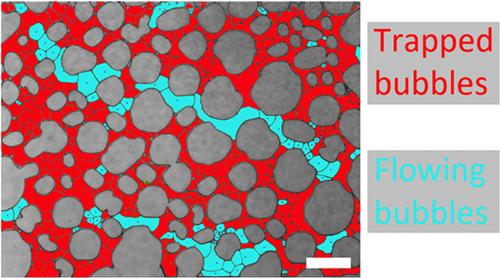非均质微流控多孔介质中泡沫迁移率及泡沫结构分析
IF 3.9
3区 工程技术
Q2 ENGINEERING, CHEMICAL
引用次数: 0
摘要
从提高石油工业的采收率到水力压裂现场的碳封存,泡沫在应用中都是必不可少的。因此,了解与泡沫相关的基本物理化学过程以预测其在天然多孔介质环境中的行为具有很大的兴趣。微流体已被证明在可视化小尺度事件和过程方面是有效的,否则在自然受限系统中很难观察到。本研究采用模拟天然非均质砂岩多孔介质的微流控装置,研究了准稳态流动泡沫中不同气体类型对气体捕获、泡沫结构、泡沫稳定性和相迁移率的影响。对不同表面活性剂浓度的氮气泡沫进行了评价。在微流控装置中直接观察了泡沫气泡捕获和层状分裂等现象,并比较了不同泡沫质量和不同表面活性剂浓度的泡沫。在这些情况下,泡沫的特征是压降、表观粘度、泡沫流动性和泡沫结构的变化。通过结合高速成像和图像处理,可以深入了解泡沫纹理与泡沫质量和流量的关系。用实验结果评价了泡沫种群平衡模型以及捕获泡沫织构与捕获分数之间的关系。研究发现,截留泡沫直接影响其表观粘度,而流动泡沫的大小也起着重要作用。我们还探讨了孔径在泡沫气泡生成中的作用,发现小于平均孔径的气泡可以作为泡沫强度的一个指标。利用图像分析结果,还对天然气种群平衡进行了评估。本文章由计算机程序翻译,如有差异,请以英文原文为准。

Analysis of Foam Mobility and Foam Texture in Heterogeneous Microfluidic Porous Media
Foams are essential in applications ranging from enhanced oil recovery in the oil industry to carbon sequestration in hydraulic fracking sites. Thus, there is a great interest in understanding the fundamental physicochemical processes associated with foam to predict its behavior in natural porous media environments. Microfluidics have been proven to be effective in visualizing small-scale events and processes that would otherwise be difficult to observe in natural confined systems. In this study, a microfluidic device designed to mimic natural heterogeneous sandstone porous media is employed to investigate the effects of gas types on gas trapping, foam texture, foam stability, and phase mobility in quasi-steady-state flowing foam. Nitrogen foam of varied surfactant concentrations is evaluated in this work. Phenomena such as foam bubble trapping and lamellar division are directly observed in microfluidic devices and compared among different foam qualities and surfactant concentrations. In these cases, foam was characterized by pressure drops, apparent viscosities, foam mobility, and variations in foam texture. An in-depth comprehension of foam texture, in relation to foam quality and flow, is possible by combining high-speed imaging and image processing. A foam population balance model and the relationship between the trapped foam texture and trapped fraction were evaluated with experimental results. It was found that trapped foam directly contributes to its apparent viscosity, while the sizes of flowing foam bubbles also play an important role. We also probed the role of pore size in foam bubble generation and found that bubbles smaller than the average pore size could be an indicator of foam strength. Gas population balance was also evaluated using results from image analysis.
求助全文
通过发布文献求助,成功后即可免费获取论文全文。
去求助
来源期刊

Industrial & Engineering Chemistry Research
工程技术-工程:化工
CiteScore
7.40
自引率
7.10%
发文量
1467
审稿时长
2.8 months
期刊介绍:
ndustrial & Engineering Chemistry, with variations in title and format, has been published since 1909 by the American Chemical Society. Industrial & Engineering Chemistry Research is a weekly publication that reports industrial and academic research in the broad fields of applied chemistry and chemical engineering with special focus on fundamentals, processes, and products.
 求助内容:
求助内容: 应助结果提醒方式:
应助结果提醒方式:


